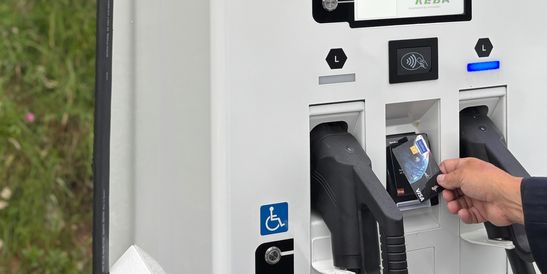“Making sure the battery gets fully charged”
- Private
- Charging
- Business
- Technical

Contents

Interview with Armin Weberberger - EV Compliance-Tester & Customer Solution Manager at KEBA Energy Automation:
Let’s start by introducing you: What is your job here at KEBA Energy Automation?
Along with EV compliance testing, as Customer Solutions Manager I am also the technical contact for Austrian charge point operators. I accompany the customers on their way to a perfectly tailored charging solution and am also available when it is in operation to answer any questions they might have.
How does one become what you are? And how long have you been working at the compa-ny?
When I graduated high school I already knew that I’d later want a job that had to do with sustainability, renewable energy, and mobility transition. That’s why I enrolled in the “Eco-Energy Engineering” programme at the Wels University of Applied Sciences, which was later renamed “Applied Energy Engineering.” My enthusiasm for electromobility led me to start working for KEBA four years ago, right after completing my studies. After two years in software quality control, I decided to focus more on the customer side of things. The internal transition was very smooth.
Your tasks include compatibility testing, which ensures that all new electric cars can be charged with our wallboxes. How many different EV and PHEV models have you tested so far?
My colleagues and I have had countless vehicles pass through our hands over the last few years. Both for the compatibility tests and our internal software approval tests. Special cars, which is to say, particularly small, large, fast, cheap, or expensive ones, and of course new models make our job even more colourful and exciting.
The amount of electric vehicles and plug-in hybrids has indeed grown rapidly. This presents a challenge to us testers – one which, admittedly, we’re very happy to accept.

What does such a test look like? What do you look for?
We usually get these cars fully charged, so we often have to take them for a spin to get enough space in the battery – not the worst part of our job 😊. Then we drive to the underground car park for the test setting, which consists of various series of KEBA P30 wallboxes, and get to work. When testing, we make sure that the vehicle charges the way we expect it to charge. Does it comply with our power specifications? Does it react correctly to the load management? Does it wake up again after it’s been paused by the charging station, when the charging network didn’t have enough power? Does charging work even when I first authorize and then plug in the cable?
Do you run into problems every now and then?
Yes, we always notice one or the other small complication. Many of them usually come from the vehicle itself: One doesn’t charge under a minimum current of 13A, the other falls asleep when load management pauses or when it is locked by the user and the key is not within range. The things we notice when testing, we pass on via the retailer to the automaker – after all, a software update can swiftly remedy a situation in this day and age. Of course, we also inform our own support team to prepare them for the corresponding customer inquiries.
Especially last year, many new electric vehicles have been brought on the market. This year will be no different. That might mean more testing for you!
The amount of electric vehicles and plug-in hybrids has indeed grown rapidly. This presents a challenge to us testers – one which, admittedly, we’re very happy to accept. But the long supply periods have currently made it harder to get the desired test vehicles; the dealers don’t even get floor models. Here, the carry-over parts policies of corporations play into our hands, as several vehicles have the same platform and use the same batteries and charging devices and are therefore identical in their charging behaviour.
Impressions from the compatibility test
Related articles
Locations
Newsroom

Edge
Chrome
Safari
Firefox






